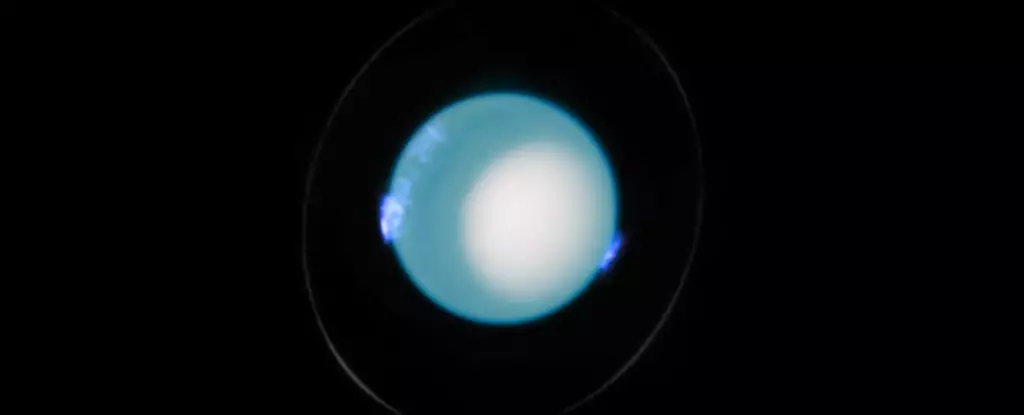In recent scientific advancements, new findings have shed light on a fundamental aspect of Uranus that had long been misunderstood: the length of its day. Previously, it was believed that Uranus completed a full rotation in approximately 17 hours and 14 minutes. However, fresh data revealed that the actual duration is more precise, clocking in at 17 hours, 14 minutes, and 52 seconds—an adjustment of 28 seconds that may seem trivial on the surface, but is monumental in the realm of planetary science. This seemingly minor revision promises to unravel a multitude of enigmas surrounding the ice giant, enhancing our comprehension of its structure, atmosphere, and magnetic field.
Revolutionizing Our Understanding
The impacts of this new measurement extend far beyond mere academic curiosity. As Laurent Lamy from the Paris Observatory pointed out, the newly refined day length plays a critical role in establishing an accurate coordinate system for mapping Uranus. Prior inaccuracies had severe implications for tracking the planet’s magnetic poles, leading to a loss of orientation and muddling previous scientific efforts to understand its geomagnetic behavior. By rectifying this discrepancy, scientists can now build upon existing data and create reliable models for future explorations.
Additionally, Uranus and its sibling, Neptune, reside in the far reaches of our solar system, creating a unique set of challenges for researchers. The great distances from the Sun render these planets dim and difficult to observe, which was especially evident during the Voyager 2 flyby in 1986 when only a snapshot of Uranus could be captured. The new measurement not only adds a layer of reliability to the data obtained decades ago but also prompts deeper investigations into the hidden phenomena surrounding both planets.
The Challenges of Distance and Technology
The difficulty of exploring Uranus stems from its considerable distance—twice as far from the Sun as Saturn. Traditional methods of observation, limited by both distance and technology, constrain researchers in gathering comprehensive insights about such distant worlds. In the face of these constraints, the Hubble Space Telescope has proven invaluable. By meticulously analyzing ultraviolet auroras produced by solar wind interactions with Uranus’s magnetosphere over an eleven-year span, researchers have achieved a significant breakthrough. Not only have they pinpointed the exact rotational axis of the planet, but they have also measured details that were reliant on historically flawed assumptions.
Interestingly, the orientation of Uranus’s rotational axis is nearly parallel to the ecliptic plane, in stark contrast to the perpendicular alignments found in most other planets. This peculiar positioning complicates the identification of its magnetic poles, presenting an intricate puzzle for scientists attempting to understand the planet’s overall dynamics. In managing to track the ultraviolet auroras, researchers have unlocked the secret to accurately mapping Uranus’s magnetic features and, in doing so, regained control over its coordinate systems.
A New Era of Measurement Techniques
The precision with which Lamy and his team measured the length of Uranus’s day sets a new standard for rotational measurements of gas giants. The methodology—an innovative technique utilizing the Hubble observations—surpasses even the precision achieved with measurements of Jupiter’s rotation. This advancement signals a promising future for planetary science, as similar techniques could soon be applied to other giant planets within our solar system, paving the way for more accurate assessments of their inner workings.
The implications of these findings are wide-ranging. With a newly calibrated longitude system, planetary scientists can analyze auroral observations that span close to four decades, allowing for a comprehensive comparison and deeper understanding of temporal changes in Uranus’s magnetosphere. Furthermore, this newfound precision enhances the groundwork for future missions to Uranus, enabling researchers to anticipate and prepare for specific scientific objectives more effectively.
The additional 28 seconds in Uranus’s day may not be headline news to the casual observer, but for those in the scientifically-inclined community, it stands as a testament to how fleeting moments in technological advancement can revolutionize our understanding of the cosmos. With each new measurement and observation, we draw closer to answering the myriad questions surrounding our solar system’s mysteries, reconciling past errors, and pushing the boundaries of our knowledge further into the magnificent unknown. The journey of discovery is not just about a single planet; it symbolizes humanity’s relentless pursuit of understanding the universe in which we reside.


Leave a Reply